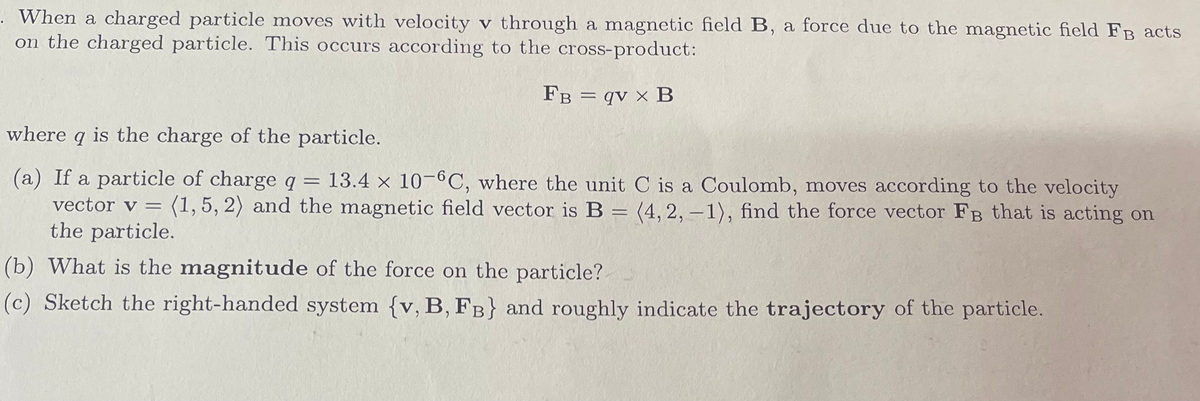When a charged particle moves with velocity v through a magnetic field B, a force due to the magnetic field FB acts on the charged particle. This occurs according to the cross-product: FB = qv x B where q is the charge of the particle. (a) If a particle of charge q = 13.4 x 10-6C, where the unit C is a Coulomb, moves according to the velocity vector v = (1, 5, 2) and the magnetic field vector is B = (4, 2, -1), find the force vector FB that is acting on the particle. b) What is the magnitude of the force on the particle? =) Sketch the right-handed system {v, B, FB} and roughly indicate the trajectory of the particle.
When a charged particle moves with velocity v through a magnetic field B, a force due to the magnetic field FB acts on the charged particle. This occurs according to the cross-product: FB = qv x B where q is the charge of the particle. (a) If a particle of charge q = 13.4 x 10-6C, where the unit C is a Coulomb, moves according to the velocity vector v = (1, 5, 2) and the magnetic field vector is B = (4, 2, -1), find the force vector FB that is acting on the particle. b) What is the magnitude of the force on the particle? =) Sketch the right-handed system {v, B, FB} and roughly indicate the trajectory of the particle.
Related questions
Question
Can you help me with these three. parts and can you show me how to do it step by step solving these three. problems. so I CAN UNDERStand it better
thank you

Transcribed Image Text:. When a charged particle moves with velocity v through a magnetic field B, a force due to the magnetic field FB acts
on the charged particle. This occurs according to the cross-product:
FB qv x B
=
where q is the charge of the particle.
(a) If a particle of charge q = 13.4 x 10-6C, where the unit C is a Coulomb, moves according to the velocity
vector v = (1, 5, 2) and the magnetic field vector is B = (4, 2, -1), find the force vector FB that is acting on
the particle.
(b) What is the magnitude of the force on the particle?
(c) Sketch the right-handed system {v, B, FB} and roughly indicate the trajectory of the particle.
Expert Solution
This question has been solved!
Explore an expertly crafted, step-by-step solution for a thorough understanding of key concepts.
This is a popular solution!
Trending now
This is a popular solution!
Step by step
Solved in 5 steps with 22 images
